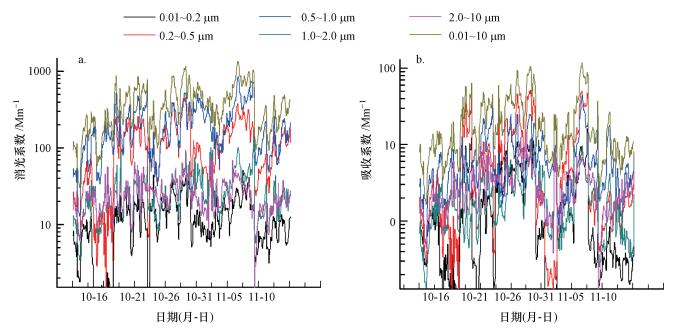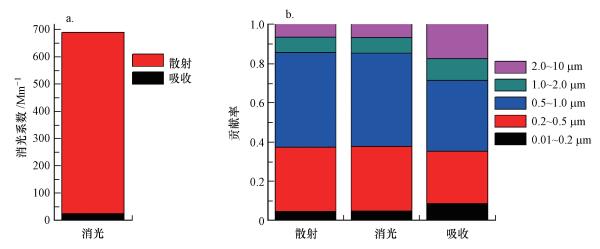
 , 付泽宇1, 沈艳2, 石美亮1, 崔毅1
, 付泽宇1, 沈艳2, 石美亮1, 崔毅11. 南京信息工程大学中国气象局气溶胶-云-降水重点开放实验室, 气象灾害预报预警与评估协同创新中心, 南京 210044;
2. 浙江省奉化市气象局, 奉化 315500
收稿日期: 2017-08-10; 修回日期: 2017-11-17; 录用日期: 2017-12-09
基金项目: 国家重点研发计划课题(No.2016YFA0602003);国家重点研究开发项目(No.2016YFC0202403);国家自然科学基金(No.41005071,41275152)
作者简介: 张泽锋(1978-), 男, E-mail:zhangzf01@vip.163.com
通讯作者(责任作者): 张泽锋, E-mail:zhangzf01@vip.163.com
摘要: 黑碳是气溶胶粒子中最重要的吸收性组分,对大气辐射过程、气候系统具有重要影响.理论上黑碳的光吸收能力除了与质量相关外,还与粒径分布、混合方式有关,由于黑碳粒子的不可溶性,核壳结构可能是含黑碳气溶胶粒子的重要存在形态.本研究利用2013年10月15日-11月13日的观测数据,结合κ-EC-米散射模型对核壳结构假设下的大气气溶胶的消光特性进行了定量分析,计算了核壳结构假设下气溶胶的吸收系数和吸收对消光的贡献,并对不同粒径段吸收系数随相对湿度增长的规律进行了分析.结果表明,观测期间吸收对消光的平均贡献在干态下为5.8%,而在环境相对湿度下只有3.4%,在所有粒径段消光系数随相对湿度都是显著增加的,而吸收系数的吸湿增长曲线与气溶胶粒径密切相关,小粒径段的吸收随相对湿度的增加而增加,而大粒径段的吸收随相对湿度的增加而减小,在不同粒径段的粒子综合作用下吸收随相对湿度变化不明显.
关键词:黑碳消光贡献相对湿度核壳模型
Contribution of black carbon absorption to atmospheric extinction in Nanjing under the core shell model
ZHANG Zefeng1

 , FU Zeyu1, SHEN Yan2, SHI Meiliang1, CUI Yi1
, FU Zeyu1, SHEN Yan2, SHI Meiliang1, CUI Yi1 1. Collaborative Innovation Center on Forecast and Evaluation of Meteorological Disasters, Key Laboratory for Aerosol-Cloud-Precipitation of China Meteorological Administration, Nanjing University of Information Science & Technology, Nanjing 210044;
2. Fenghua Meteorological Bureau of Zhejiang Province, Fenghua 315500
Received 10 August 2017; received in revised from 17 November 2017; accepted 9 December 2017
Supported by the National Key Research and Development Program of China (No.2016YFA0602003), the National Key Research and Development Project (No.2016YFC0202403) and the National Natural Science Foundation of China(No.41005071, 41275152)
Biography: ZHANG Zefeng(1991―), male, E-mail: zhangzf01@vip.163.com
*Corresponding author: ZHANG Zefeng. E-mail:zhangzf01@vip.163.com
Abstract: Black carbon is the most important absorptive component of aerosol particles, and has an important impact on atmospheric radiation and climate system.The light absorption capacity of black carbon is related to the mass concentration, particle size distribution and mixing state. The core-shell structure may be an important existence form of the black carbon aerosol due to its insolubility. Under the assumption of core-shell structure, the extinction property of atmospheric aerosol were analyzed by the κ-EC-Mie scattering model using the data from October 15 to November 13, 2013. The contribution of aerosol absorption to the extinction coefficient was calculated. The absorption coefficient of different aerosol size distribution with the increase of relative humidity (RH) was analyzed. The average contribution of absorption to extinction is 5.8% in the dry state and 3.4% in ambient relative humidity, respectively. The extinction coefficient increased significantly with RH in all size, while the hygroscopic growth curve of absorption coefficient was related to the aerosol size. The absorption coefficient of small particles increased with RH, while that of large particle decreased. The absorption of the particles with different particle size showed not obvious change with RH.
Key words: black carbonextinction contributionrelative humiditycore-shell model
1 引言(Introduction)大气气溶胶通过影响大气的辐射特性, 进而影响地球的气候与温度, 其中, 产生正辐射强迫的气溶胶主要是黑碳气溶胶.黑碳气溶胶能够吸收太阳辐射, 加热大气, 对地面有增温效应, 从而影响地气系统的辐射平衡(杜川利等, 2013).联合国政府间气候变化专门委员会(IPCC)第五次评估报告中认为黑碳是仅次于CO2的正强迫因子, 因此, 黑碳气溶胶对太阳辐射的强吸收作用已经成为气溶胶气候效应研究中的一个重要内容(Haywood et al., 2000;Menon et al., 2002).
目前国内外已经开展了不少黑碳相关的观测工作, 测量了典型地区的黑碳浓度.如蔡子颖等(2011)发现, 天津市夏季黑碳气溶胶浓度均值为6.3 μg·m-3, 占PM10质量浓度的4.17%.Zhou等(2012)在华南地区观察到的有机碳(OC)和元素碳(EC)的平均浓度分别为(3.01±2.20)和(0.54±0.30) μg·m-3, 总含碳气溶胶(TCA)平均占PM2.5的20.7%.Fan等(2004)研究了英国不列颠下弗雷泽谷地区细颗粒碳质成分的特征, 由IOGAPS测定的平均OC为2.80 μg·m-3(以C计), 比由FP测定的平均OC(3.59 μg·m-3, 以C计)低约28%.Wang等(2011)研究了泰山的黑碳气溶胶, 发现不挥发有机碳(NVOC)、元素碳(EC)在春季和夏季分别显示高浓度, 平均值分别为6.07、1.77和5.05、0.99 μg·m-3, 而春季半挥发性有机碳(SVOC)的平均浓度为6.26 μg·m-3, 夏季为13.33 μg·m-3.
然而大气经过复杂的老化过程, 具有复杂的混合方式, 不同的混合方式影响了气溶胶的尺度分布、折射指数, 从而影响气溶胶的光学特性(牛生杰等, 2001).早在1978年Heintzenberg就已经认识到, 由于城市气溶胶的复杂混合状态, 使得它们的光吸收质量相较于同样含量的元素碳外混合状态时的光吸收量更多, 最多时候可增加吸收2倍左右(Heintzenberg, 1978).Jacobson(2001)在全球气候三维模型中比较了不同混合方式下的辐射强迫因子的差异, 结果表明, 内混合模型和核壳模型的辐射强迫因子分别是外混合模型的3倍和2倍.此后不同研究小组从实验、理论等方面探讨了混合方式对吸收的影响, 发现混合方式不同的元素碳的辐射强迫因子有较大变化(0.16~0.80 W·m-2), 因而在考虑黑碳吸收效应的同时应考虑混合方式.考虑到黑碳具有吸附性和不溶于水的特性, 我们认为含黑碳气溶胶可能更接近于核壳结构, Péré等(2009)采用单颗粒散射反照率法进行的观测在一定程度上证实了这一点.同时, 高相对湿度条件下, 气溶胶的光学特性能够发生显著的变化, 如Zhang等(2017)利用吸湿性参数κ, 结合米散射理论, 建立了κ-EC-米散射模型, 很好地拟合了大气气溶胶消光系数随相对湿度变化的曲线.
本研究利用2013年10月15日—11月13日在南京的观测数据, 结合κ-EC-米散射模型对不同粒径的气溶胶粒子的消光、吸收特性进行讨论, 并给出消光系数、吸收系数随相对湿度增长曲线.通过对不同粒径段气溶胶粒子的消光、吸收系数随相对湿度的吸湿增长曲线的分析, 探讨在观测浓度下, 气溶胶吸收系数随相对湿度增加的变化规律.
2 实验方法(Experiment and methods)2.1 观测数据与仪器采样点位于南京市浦口区南京信息工程大学气象楼(32.207°N, 118.717° E)12楼, 离地高度40 m, 在其东、东北、东南侧4~5 km距离为工业园区(包括石化、钢铁、电力等企业), 东侧500 m还受宁六高速影响, 南侧受主城区影响, 西侧毗邻国道(机动车流量大), 周边为居民区.采样时间为2013年10月15日—11月13日(Zhang et al., 2017).表 1给出了本次观测所用的主要仪器及观测内容.
表 1(Table 1)
| 表 1 主要仪器与观测内容 Table 1 Main instruments and observations | ||||||||||||||||||||||||
表 1 主要仪器与观测内容 Table 1 Main instruments and observations
| ||||||||||||||||||||||||
2.2 核壳模型下气溶胶粒子的消光、散射计算方法本研究假设气溶胶粒子符合κ-EC-Mie模型下的核壳结构特性(Zhang et al., 2017), 包含如下假设:①相同粒径的气溶胶粒子具有相同的理化性质, 气溶胶粒子是“球形”的;②干态气溶胶是由光吸收物质元素碳和非光吸收物质组成, 且元素碳为球形“核”, 始终位于气溶胶的中央;③气溶胶粒子的吸湿增长因子是吸湿性参数的函数, 元素碳不能吸收水分, 非光吸收物质吸收水分后与水均匀混合.
根据核壳模型的假设, 采用公式(1)可计算出在核壳模型下大气中气溶胶的消光系数和散射系数, 吸收系数为消光系数与散射系数的差值.
 | (1) |
 | (2) |
公式(3)、(4)中, Xcor为“核”的尺度参数, Xman为气溶胶的尺度参数, D0为单颗粒气溶胶干态时的直径, λ为入射光波长, 取值为550 nm.
 | (3) |
 | (4) |
 | (5) |
图 1(Fig. 1)
 |
| 图 1 干态下气溶胶粒子消光系数(a)和吸收系数(b)随时间的变化 Fig. 1Changes of extinction coefficient (a) and absorption coefficient (b) of aerosol particles over time in dry state |
图 2(Fig. 2)
 |
| 图 2 干态下吸收占消光的比例(a)及不同粒径段粒子的散射、吸收、消光贡献率(b) Fig. 2Proportion of absorption to extinction(a) and the scattering, absorption and extinction contribution of different particle sizes (b) in dry state |
3.2 环境相对湿度下不同粒径段黑碳吸收对大气消光的贡献图 3给出了在环境相对湿度下不同粒径段气溶胶粒子的消光系数和吸收系数随时间变化的曲线, 图 4给出了观测期间消光、吸收的平均值和不同粒径段对消光、散射和吸收的贡献.环境相对湿度下GF由公式(2)计算得到, 相对湿度数据是观测数据.从图 3和图 4可知, 在环境相对湿度下与干态下相似, 消光的主要贡献来自散射的贡献, 吸收的贡献只占3.4%, 值得注意的是, 吸收对消光的贡献较干态有所降低.与干态相似, 不同粒径段对消光、散射、吸收的贡献也有较大差异, 0.5~1.0与0.2~0.5 μm粒径段粒子的贡献最大.0.5~1.0 μm粒径段粒子的消光、散射和吸收贡献分别为47.7%、48%和36%, 较干态而言, 均有减小.而0.2~0.5 μm粒径段粒子的消光、散射和吸收贡献分别为33%、33%和27%, 相较于干态均有所增大.
图 3(Fig. 3)
 |
| 图 3 环境相对湿度下气溶胶粒子消光系数(a)和吸收系数(b)随时间的变化 Fig. 3Changes of extinction coefficient (a) and absorption coefficient (b) of aerosol particles over time in ambient relative humidity |
图 4(Fig. 4)
 |
| 图 4 环境相对湿度下吸收占消光的比例(a)及不同粒径段粒子的散射、吸收、消光贡献率(b) Fig. 4Proportion of absorption to extinction (a) and contribution rate of scattering, absorbing and extinction of particles with different sizes (b) in ambient relative humidity |
3.3 干态下与环境相对湿度下黑碳吸收对消光贡献不同粒径段粒子对大气消光系数贡献的变化响应程度不同, 这与其在环境相对湿度下的消光增长速率有关.以图 3a与图 1a, 以及图 3b与图 1b的结果相除结果为纵坐标, 并以相对湿度为横坐标, 可得到不同粒径段的消光系数、吸收系数的吸湿增长曲线, 结果如图 5所示.其中, 图 5a还给出了5个粒径段的拟合公式, R2均在0.8以上, 这说明各粒径段的气溶胶消光系数随着相对湿度的变化具有一致性.由图 5a可知, 不同粒径段粒子的消光系数随着相对湿度的增加而增加, 但其增加的速度有显著的差异, 其中, 0.01~0.2 μm粒径段粒子的消光系数随着相对湿度变大增加的最快, 其次为0.2~0.5和1.0~2.0 μm粒径段, 而2.0~10.0和0.5~1.0 μm粒径段粒子消光系数随环境相对湿度增长最不显著.图 5b表示各粒径黑碳吸收系数随相对湿度的变化关系, 可以看出, 不同粒径黑碳的吸收系数随环境相对湿度的变化也不尽相同, 0.01~0.2与0.2~0.5 μm粒径段粒子的吸收系数随环境相对湿度增加而增大, 而1.0~2.0、0.5~1.0和2.0~10.0 μm粒径段粒子的吸收系数随环境相对湿度增加而有所减小.这是由不同粒径段粒子的吸收系数随相对湿度增加变化规律的差异性导致, 总体上气溶胶粒子的吸收系数随相对湿度增加的变化没有明显规律, 受到大粒子和小粒子的比值制约.比较图 5a和5b可以看出, 无论是哪个粒径段, 核壳结构的吸收系数随相对湿度的增长曲线均小于散射系数的增长曲线, 这表明随相对湿度的增加吸收对消光的贡献总是下降的.
图 5(Fig. 5)
 |
| 图 5 相对湿度对气溶胶粒子消光(a)和吸收(b)的影响 Fig. 5Effect of relative humidity on extinction (a) and absorption (b) of aerosol particles |
4 结论(Conclusions)1) 干态下, 大部分的大气消光、吸收来自于0.2~0.5及0.5~1.0 μm粒径段粒子的贡献, 两个粒径段总的消光贡献达81%, 总吸收达63%.环境相对湿度下, 大部分的大气消光也来自于0.2~0.5及0.5~1.0 μm粒径段粒子的贡献, 约占总消光的80%, 吸收与干态下相同.不同粒径段粒子在环境相对湿度条件变化时其消光与吸收的变化不同.环境相对湿度下黑碳吸收对消光的贡献约为3.4%, 小于干态下黑碳吸收对消光的贡献(5.4%).
2) 随着环境相对湿度的增加, 气溶胶消光系数、散射系数的变化规律有显著差异.随相对湿度的增加, 不同粒径段粒子消光系数的增长速率不同, 但基本趋势一致, 而吸收系数的增长与粒径有关, 总体上小粒径段气溶胶的吸收系数随相对湿度的增加而增加, 大粒径段气溶胶粒子则有减小的趋势.在大、小粒子的综合作用下, 总吸收系数几乎与相对湿度无关, 但这一结果可能是由观测期间气溶胶独特的理化特性决定的.
参考文献
| Aklilu Y, Mozurkewich M, Prenni A J, et al. 2006. Hygroscopicity of particles at two rural, urban influenced sites during Pacific 2001:Comparison with estimates of water uptake from particle composition[J]. Atmospheric Environment, 40(15): 2650–2661.DOI:10.1016/j.atmosenv.2005.11.063 |
| Bond T C, Bergstrom R W. 2006. Light absorption by carbonaceous particles:An investigative review[J]. Aerosol Science & Technology, 40(40): 27–67. |
| 蔡子颖, 韩素芹, 黄鹤, 等. 2011. 天津夏季黑碳气溶胶及其吸收特性的观测研究[J]. 中国环境科学, 2011, 31(5): 719–723. |
| 车慧正, 石广玉, 张小曳. 2007. 北京地区大气气溶胶光学特性及其直接辐射强迫的研究[J]. 中国科学院研究生院学报, 2007, 24(5): 699–704. |
| 杜川利, 余兴, 李星敏, 等. 2013. 西安泾河夏季黑碳气溶胶及其吸收特性的观测研究[J]. 中国环境科学, 2013, 33(4): 613–622. |
| Eichler H, Cheng Y F, Birmili W, et al. 2008. Hygroscopic properties and extinction of aerosol particles at ambient relative humidity in South-Eastern China[J]. Atmospheric Environment, 42(25): 6321–6334.DOI:10.1016/j.atmosenv.2008.05.007 |
| Fan X, Brook J R, Mabury S A. 2004. Measurement of organic and elemental carbon associated with PM2.5 during Pacific 2001 study using an integrated organic gas and particle sampler[J]. Atmospheric Environment, 38(34): 5801–5810.DOI:10.1016/j.atmosenv.2004.01.052 |
| Ferron G A, Karg E, Busch B, et al. 2005. Ambient particles at an urban, semi-urban and rural site in Central Europe:hygroscopic properties[J]. Atmospheric Environment, 39(2): 343–352.DOI:10.1016/j.atmosenv.2004.09.015 |
| Haywood J, Boucher O. 2000. Estimates of the direct and indirect radiative forcing due to tropospheric aerosols:a review[J]. Reviews of Geophysics, 38(4): 513–543.DOI:10.1029/1999RG000078 |
| Heintzenberg J. 1978. Light scattering parameters of internal and external mixtures of soot and non-absorbing material in atmospheric aerosols[C]. Proceedings of the Conference on Carbonaceous Particles in the Atmosphere |
| 胡荣章, 刘红年, 张美根, 等. 2009. 南京地区大气灰霾的数值模拟[J]. 环境科学学报, 2009, 29(4): 808–814. |
| Hugwant C B, Cachier H, Bessafi M, et al. 2000. Impact of traffic on black carbon aerosol concentration at la Reunion Island(Southern Indian Ocean)[J]. Atmospheric Environment, 34(20): 3463–3473.DOI:10.1016/S1352-2310(99)00405-7 |
| IPCC. 2013. Climate Change 2013:The Scientific Basis[M]. New York: Cambridge University Press. |
| Jacobson M Z. 2001. Strong radiative heating due to the mixing state of black carbon in atmospheric aerosols[J]. Nature, 409(6821): 695–697.DOI:10.1038/35055518 |
| Lesins G, Chylek P, Lohmann U. 2002. A study of internal and external mixing scenarios and its effect on aerosol optical properties and direct radiative forcing[J]. Journal of Geophysical Research Atmospheres, 107(D10).DOI:10.1029/2001JD000973 |
| 李建云, 张杰, 田密. 2009. 中国地区黒碳气溶胶直接辐射效应的数值模拟研究[J]. 气象与减灾研究, 2009, 32(1): 17–24. |
| Liu L, MishchenkoM I, Menon S, et al. 2002. The effect of black carbon on scattering and absorption of solar radiation by cloud droplets[J]. Journal of Quantitative Spectroscopy & Radiative Transfer, 74(2): 195–204. |
| Massling A, Stock M, Wehner B, et al. 2009. Size segregated water uptake of the urban submicrometer aerosol in Beijing[J]. Atmospheric Environment, 43(8): 1578–1589.DOI:10.1016/j.atmosenv.2008.06.003 |
| McMeeking G R, Morgan W T, et al. 2011. Black carbon aerosol mixing state, organic aerosols and aerosol optical properties over the United Kingdom[J]. Atmospheric Chemistry and Physics, 11(240): 9037–9052. |
| Menon S, Hansen J, Nazarenko L, et al. 2002. Climate effects of black carbon aerosols in China and India[J]. Science, 297(5590): 2250–2253.DOI:10.1126/science.1075159 |
| 牛生杰, 孙继明. 2001. 贺兰山地区大气气溶胶光学特征研究[J]. 高原气象, 2001, 20(3): 298–301. |
| Mochida M, Kuwata M, Miyakawa T, et al. 2006. Relationship between hygroscopicity and cloud condensation nuclei activity for urban aerosols in Tokyo[J]. Journal of Geophysical Research Atmospheres, 111(D23): 5525–5536. |
| Novakova T, Hansen J E. 2004. Black carbon emissions in the United Kingdom during the past four decades:an empirical analysis[J]. Atmospheric Environment, 38(25): 4155–4163.DOI:10.1016/j.atmosenv.2004.04.031 |
| Pakkanen T A, Kermien V M, Ojanen C H, et al. 1998. Atmospheric black carbon in Helsinki[J]. Journal of Aerosol Science, 29(9): 1497–1506. |
| Péré J C, Mallet M, Bessagnet B, et al. 2009. Evidence of the aerosol core-shell mixing state over Europe during the heat wave of summer 2003 by using CHIMERE simulations and AERONET inversions[J]. Geophys Res Lett, 36(9): 1–5. |
| Sakurai H, Fink M A, McMurry P H, et al. 2005. Hygroscopicity and volatility of 4-10 nm particles during summertime atmospheric nucleation events in urban Atlanta[J]. Journal of Geophysical Research Atmospheres, 110(D22): 3033–3043. |
| Schkolnik G, Chand D, Hoffer A, et al. 2007. Constraining the density and complex refractive index of elemental and organic carbon in biomass burning aerosol using optical and chemical measurements[J]. Atmospheric Environment, 41(5): 1107–1118.DOI:10.1016/j.atmosenv.2006.09.035 |
| 沈艳. 2016. 运用κ-EC-Mie模型探讨相对湿度对南京北郊气溶胶消光特性的影响[D]. 南京: 南京信息工程大学 |
| 汤莉莉, 祝愿, 牛生杰, 等. 2011. 南京北郊大气细粒子中黑碳气溶胶的观测研究[J]. 环境科学学报, 2011, 31(4): 709–716. |
| Tschiersch J, Busch B, Fogh C L. 1997. Measurements of concentration, size distribution and hygroscopicity of Munich winter aerosol[J]. Journal of Aerosol Science, 28(28): 209–210. |
| 王红磊, 朱彬, 沈利娟, 等. 2014. 春节期间南京市大气气溶胶粒径分布特征[J]. 环境科学, 2014, 35(2): 442–450. |
| 王红磊. 2013. 南京市大气气溶胶理化特征观测研究[D]. 南京: 南京信息工程大学 |
| Wang H H, Sun X M. 2012. Multiple scattering of light by water cloud droplets with external and internal mixing of black carbon aerosols[J]. Chinese Physics B, 21(5): 241–246. |
| Wang Z, Wang T, Gao R, et al. 2011. Source and variation ofcarbonaceous aerosols at Mount Tai, North China:Results from asemi-continuous instrument[J]. Atmospheric Environment, 45(9): 1655–1667.DOI:10.1016/j.atmosenv.2011.01.006 |
| 吴涧, 符淙斌. 2005. 近五年来东亚春季黑碳气溶胶分布输送和辐射效应的模拟研究[J]. 大气科学, 2005, 29(1): 112–119. |
| 吴奕霄, 银燕, 顾雪松, 等. 2014. 南京北郊大气气溶胶的吸湿性观测研究[J]. 中国环境科学, 2014, 34(8): 1938–1949. |
| 吴兑, 毛节泰, 邓雪娇, 等. 2009. 珠江三角洲黑碳气溶胶及其辐射特性的观测研究[J]. 中国科学, 2009, 39(11): 1542–1553. |
| 许黎, 王亚强. 2006. 黑碳气溶胶研究进展:排放、清除和浓度[J]. 地球科学进展, 2006, 21(4): 352–360. |
| 张美根, 徐永福, 张仁健, 等. 2005. 东亚地区春季黑碳气溶胶源排放及其浓度分布[J]. 地球物理学报, 2005, 48(1): 46–51. |
| Zhang X Q, McMurray P H, Hering S V, et al. 1993. Mixing characteristics and water content of submicron aerosols measured in Los Angeles and at the Grand Canyon[J]. Atmospheric Environment, Part A.General Topics, 27(10): 1593–1607.DOI:10.1016/0960-1686(93)90159-V |
| 张瑛, 高庆先. 1997. 硫酸盐和黑碳气溶胶辐射效应的研究[J]. 应用气象学报, 1997, 8(s1): 87–91. |
| Zhang Z F, Shen Y, Li Y W, et al. 2017. Analysis of extinction properties as a function of relative humidity using a К-EC-Mie model in Nanjing[J]. Atmospheric Chemistry and Physics, 17: 4147–4157.DOI:10.5194/acp-17-4147-2017 |
| Zhou S, Wang Z, Gao R, et al. 2012. Formation of secondary organic carbon and long-range transport of carbonaceous aerosols at Mount Heng in South China[J]. Atmospheric Environment, 63: 203–212.DOI:10.1016/j.atmosenv.2012.09.021 |
